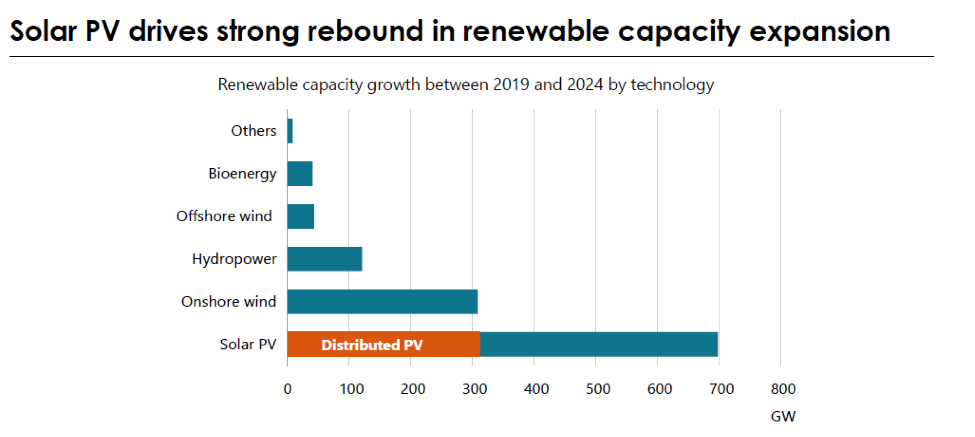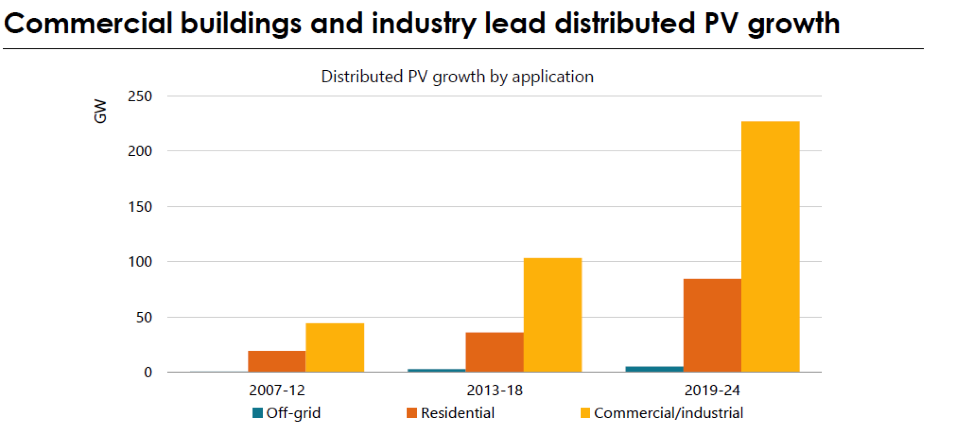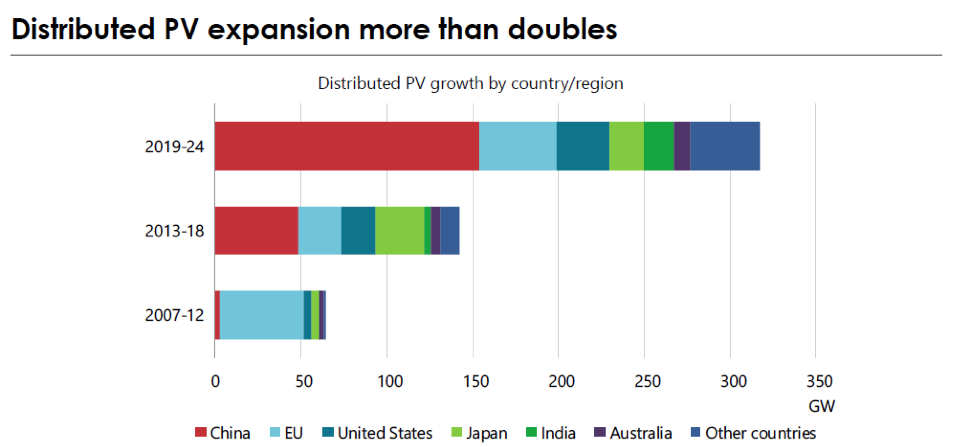According to the International Energy Agency (IEA) in its Renewables 2019 report, global renewable capacity is expected to increase by 50 percent between 2019 and 2024, with almost 60 percent in solar power and 29 percent in wind power, due to assumed lower costs in these technologies and government policies. Most of the remaining 11 percent share is in hydropower. The total capacity increase of 1,200 gigawatts would bring the renewable share to 30 percent of the global generation market.
After remaining flat last year, renewable capacity worldwide is expected to increase by 12 percent this year. It is the second largest source of generation in the world with a 25 percent share—16 percent hydropower and 9 percent wind, solar, and other renewables. Coal is the largest generation source worldwide, at 38 percent—the same as it was in 1997. Despite this projected growth in renewable capacity, IEA warns that it is insufficient for climate goals to be reached. (Note that wind and solar power’s generation is only a fraction of their capacity, generating around 25 percent to 45 percent, depending on the technology and the amount of intermittency.)

Distributed Solar Photovoltaics
Distributed photovoltaics represents almost 50 percent of the above solar share. Of that share, three-quarters is in commercial and industrial applications because economies of scale combined with better alignment of PV supply and electricity demand enable more self-consumption and bigger savings on electricity bills in the those sectors. In the residential sector, the number of solar rooftop systems is expected to more than double to about 100 million by 2024, with the top markets on a per capita basis to be in Australia, Belgium, California, the Netherlands, and Austria. Government policies promote their use, such as in California, which mandates the use of solar installations on new home construction. Distributed PV systems in homes, commercial buildings and industry have almost tripled since 2014. IEA projects the cost of generating electricity from distributed solar PV systems to decline by 15 percent to 35 percent by 2024 from today’s costs, helping to spur worldwide adoption.

Over the next five years, China accounts for almost half of the growth in global distributed PV solar, overtaking the European Union and becoming the world leader in installed capacity in 2021. Distributed PV expansion also picks up in the European Union during 2019 to 2024 period as the technology becomes more economically attractive and the policy environment improves via incentives, subsidies and mandates. While Japan remains a strong market, India and Korea are projected to emerge as new markets in Asia. Growth of distributed solar PV in North America is expected to be twice as fast between 2019 and 2024 as it was between 2013 and 2018, mainly due to installations projected for the United States.

Other Renewables
Onshore wind represents one-quarter of the expected growth in capacity while offshore wind contributes 4 percent to the increase. IEA expects offshore wind’s capacity to triple by 2024, due to competitive auctions in the European Union and expanding markets assumed for China and the United States.
Hydropower capacity growth is expected to slow, accounting for one-tenth of the total increase in global renewable capacity over the 5 year period.
IEA expects renewable heat to expand by one-fifth between 2019 and 2024, driven by China, the European Union, India and the United States. The heat and power sectors become increasingly interconnected as renewable electricity used for heat increases by over 40 percent. The share of renewable energy in total heat demand, however, is expected to remain below 12 percent in 2024.
Biofuels currently represent about 90 percent of renewable energy in transport and its consumption is expected to increase by 25 percent over the next five years. Growth is dominated by Asia, particularly China, due to energy security and air pollution concerns. Despite the rapid expansion of electric vehicles, renewable electricity only accounts for one-tenth of renewable energy consumption in transport in 2024, most of which is in China. The share of renewables in total transport fuel demand remains below 5 percent.
China is expected to have the largest biofuel production growth of any country. A 10 percent ethanol blending mandate in a number of Chinese provinces and increasing investments in production capacity result in a tripling of ethanol production by 2024. Brazil is expected to have the second-largest growth, aided by the introduction of the Renovabio programme in 2020. The United States and Brazil, however, are expected to provide two-thirds of total biofuel production in 2024.
Conclusion
IEA paints a rosy picture for renewable energy over the next five years, with its capacity increasing worldwide by 50 percent. Solar power’s share of the global capacity increase is the largest of the renewables at almost 60 percent due to government subsidies and mandates and an assumed lowering of costs. Distributed solar photovoltaics represent almost 50 percent of the global solar share, with most installations in the commercial and industrial sectors. Despite this rosy picture, the capacity increases are not sufficient to meet climate goals.



